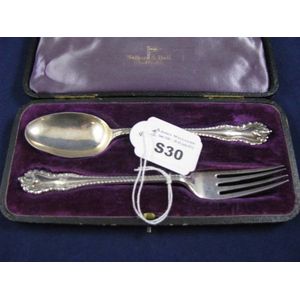Gilt Decorated Teal Art Glass Perfume Bottle
You must be a subscriber, and be logged in to view price and dealer details.
Subscribe Now to view actual auction price for this item
When you subscribe, you have the option of setting the currency in which to display prices to $Au, $US, $NZ or Stg.
- Opalescent / Opaline - The descriptions of glass as "opalescent" or "opaline" are often used interchangeably by dealers and auction houses. At the upper end of the scale, opalescent / opaline glass can refer to the opal-like milky blue glass produced by Lalique and Etling. It also refers to the pressed glass mass produced in Britain from the 1840s with a milky white edge as sugar-basins, milk jugs and vases were made in great quantities for the mass market, and were sold at fairs along with Staffordshire figures and wooden dolls. A less common type of opalescent glass was made from two layers of glass blown into a mould.
- Circa - A Latin term meaning 'about', often used in the antique trade to give an approximate date for the piece, usually considered to be five years on either side of the circa year. Thus, circa 1900 means the piece was made about 1900, probably between 1895 and 1905. The expression is sometimes abbreviated to c.1900.
- Grapevine Motif - The grapevine motif is a decorative design that features grapevines, leaves, and grapes and is commonly used in various forms of art and decoration, including jewellery, textiles, pottery, and architecture.
In jewellery, the grapevine motif is often used to create decorative elements such as pins, brooches, necklaces, and bracelets. The design can be executed in a variety of materials, including precious metals such as gold and silver, and can be embellished with gems or enamel.
The grapevine motif is a popular symbol in many cultures, representing abundance, prosperity, and fertility. In ancient times, grapevines were associated with Dionysus, the Greek god of wine and celebration, and were used to decorate wine vessels, temples, and other sacred objects.
In addition to its cultural significance, the grapevine motif is also appreciated for its aesthetic appeal. The intertwining branches and clusters of grapes create a graceful, flowing design that is both beautiful and versatile. Whether used in jewellery, textiles, or other forms of decorative arts, the grapevine motif continues to be a popular and enduring symbol of abundance and prosperity.
This item has been included into following indexes:
-
perfume / scent bottles, material
- art glass 77
- silver mounted or topped 338
- tear drop 54
Visually similar items

Cased antique sterling silver child's spoon and fork, Sheffield 1913

An Art Deco diamond brooch, five bezel set old European and Swiss cut diamonds through centre of estimated total weight 0.38 carats, surrounded by sixteen grain set rose cut diamonds of estimated total weight 0.12 carats in an elongated design. 18ct gold a

Edwardian peridot and seed pearl brooch, in presentation box

Limoges miniature flower box with posies to interior
